Please note: Use Hearing Protection ended on 3 January 2022. To find out what exhibitions and activities are open today, visit our What’s On section.
This essay originally appeared in a pamphlet given away at the Chelsea Space exhibition Use Hearing Protection: FAC 1 – 50 / 40. Please note, it contains moderate nudity and occasional use of explicit language.
There are many Factory beginnings, but one is in the radical ferment of the late sixties, to which Tony Wilson was exposed during his time at Cambridge University between 1969 and 1972. It was an era of sit-ins and violent student protest, yet the most hermetic and influential input from those years was the smattering of samizdat material from the Situationist International (SI)—in particular the magazine Internationale Situationiste—which, translated into English, started to percolate into the minds of young radicals from 1966 onwards.
That was the year in which Christopher Gray and Phillipe Vissac produced the founding translation of Raoul Vaneigem’s Totality For Kids, around the same time as Charles Radcliffe turned much of the second issue of his magazine Heatwave to Situationist ideas and writings. Shortly afterwards saw the distribution of Ten Days That Shook The University, an English translation by Christopher Gray of Mustapha Khayati’s On Student Poverty: a founding second wave SI document funded by rebellious students at Strasbourg University in late 1966.
This text had particular relevance to a restless and questing generation. On Student Poverty examined the student’s ‘stoical slave’ status—bound into a technocratic educational system by a poverty of expectations and, in many cases, financial poverty—but also recognised that his or her liminal status had revolutionary potential: ‘He does have marginal freedoms, a small area of liberty which as yet escapes the totalitarian control of the spectacle. His flexible working-hours permit him adventure and experiment.’
Students had the potential to join the world revolution of youth: ‘The best criticism of student life is the behaviour of the rest of youth, who have already started to revolt. Their rebellion has become one of the signs of a fresh struggle against modern society. After years of slumber and permanent counter-revolution, there are signs of a new period of struggle, with youth as the new carriers of revolutionary infection… The revolt of youth is the prelude to a period of revolt—the revolt of those who can no longer live in our society.’
‘Pamphlets were how I saw it’, says Paul Sieveking, a near contemporary of Wilson’s who later became editor of Fortean Times. ‘Ten Days that Shook the University was widely distributed, on the campuses, amongst students interested in contemporary radical activity. It was a discovery; you felt that it gave you a certain edge over people who didn’t know about it. That was followed by Totality for Kids, in the dark blue cover, which was hawked by this strange character who travelled the country, called Martin Housden.’
‘You’d have found this stuff in the Wooden Shoe Bookshop in Old Compton Street, and traditional anarchist bases like Freedom. Freedom was in Fulham until they moved to Whitechapel in ’69. Then one got places like the IT teashop, the swinging London thing, in Southampton Row. Better Books for a time, in Tottenham Court Road, the basement was jam-packed with samizdats and first editions of IT, all sorts of people putting out rants and manifestos.’
This SI material was ‘very much part and parcel of an underground stream that was influencing a lot of people’, Sieveking says. Cambridge was a hotbed of student radicalism at the turn of the decade, the most famous event being the Garden House Riot in February 1970. This occurred when a protest against the Greek regime, which was holding an event at the hotel, turned ugly. The hotel was invaded, a policeman hurt, chaos ruled for a few hours. ‘It was the high point of the whole thing, from a street action point of view.’
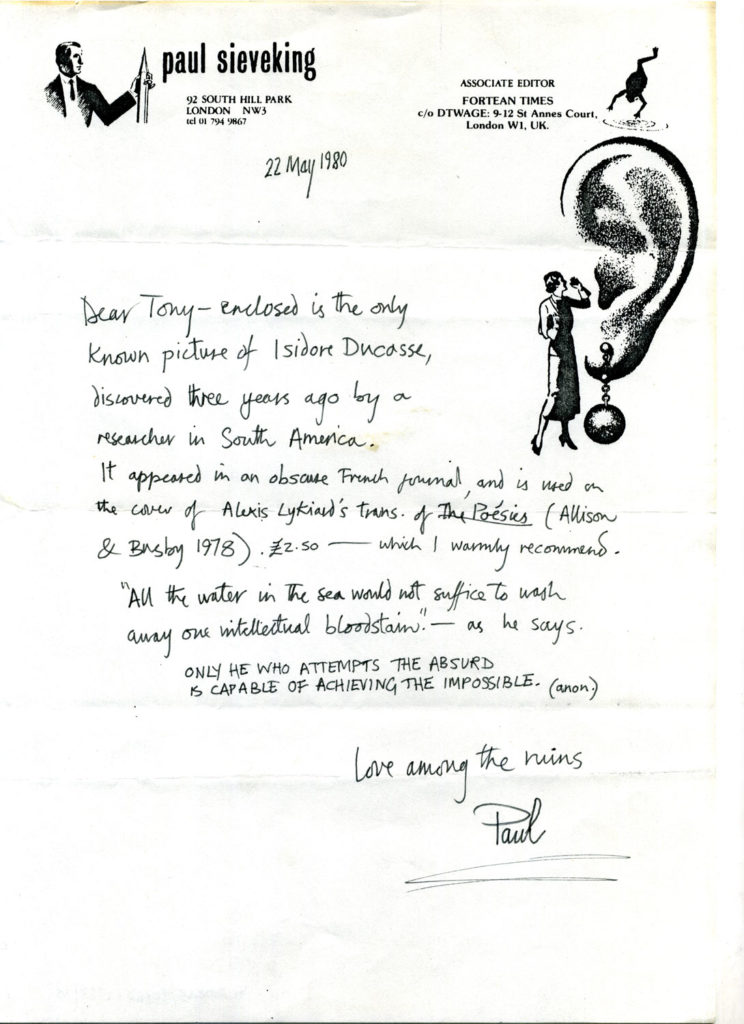
One of the students arrested and later given a condign sentence—18 months in prison—was a 21 year-old student called Rod Caird, who later wrote a book on penology before beginning to work at Granada Television. As Head of Local Programmes, he became Tony Wilson’s and my boss in the late seventies. By then, Wilson was a local institution: the co-presenter of the daily early evening news and feature programme, Granada Reports, with the more avuncular Bob Greaves.
‘Bob Greaves was the daddy figure of the news room,’ remembers the photographer Daniel Meadows. ‘Local man. And his sidekick was Tony Wilson, this foppish Cambridge graduate, who used lots of clever words in his links from item to item, and did lots of ridiculous things in a kind of flaneur style, which would be very unfamiliar to working class northerners, but was also I think rather engaging. Whenever you saw Tony Wilson out doing one of his TV reports, everyone would roll down their car windows and shout “Wanker!” at him.’
Yet there was another side to Wilson’s clowning. Since 1975 he had been fronting a local music programme called So It Goes, which featured the first ever television appearance by the Sex Pistols, the Clash, Siouxsie and the Banshees and many others. After the show was cancelled, he decided to get involved with music in a different way: supporting and releasing the local talent that had exploded after Buzzcocks’ independently released Spiral Scratch. Forming a company with Alan Erasmus, under the name The Movement of the 24th January, he began promoting Factory nights at the Russell Club in Hulme.
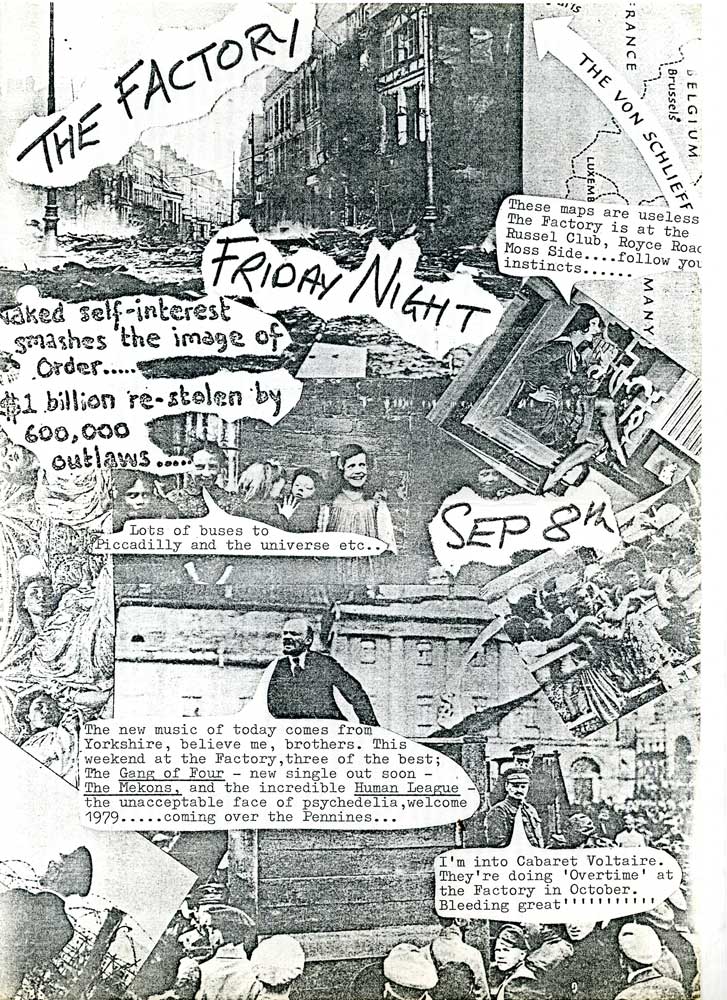
The first night was in May 1978. With no one else at hand, Wilson produced his own flyer, which promoted the first 24th of January artist, the Durutti Column. The name was taken from the famous détourned situationist artwork, designed by André Bertrand, that had graced the infamous La Retour de la Colonne Durutti pamphlet—that had sparked a major confrontation between students and the authorities at Strasbourg University in October 1966 and inspired the founding SI pamphlet Ten Days That Shook the University.
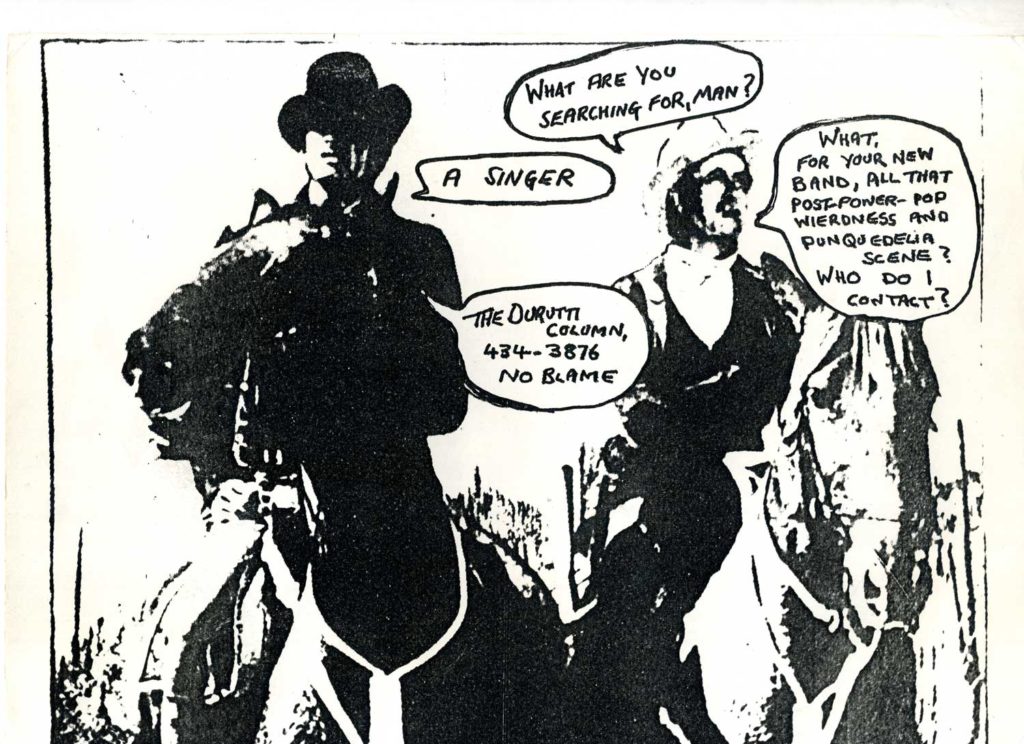
In an image taken from the 1961 film A Thunder Of Drums, the cowboys (George Hamilton and Arthur O’Connell) are riding high and meditating on the nature of the spectacle—in speech bubbles quoting from SI member Michèle Bernstein’s 1960 novel All the King’s Horses:
‘De quoi t’occupes tu exactement?’
‘De la réification.’
‘Je vois, c’est un travail très sérieux, avec de gros livres et beaucoup de papiers sur une grande table.’
‘Non, je me promène. Principalement je me promène.’
[‘What are you doing, exactly?’
‘Reification.’
‘I see, this is a very serious job, with big books and lots of papers on a big table.’
‘No, I’m going for a walk. Mainly I walk around.’]
Wandering and drifting had been an integral part of SI theory since its origin in the Paris-based Lettristes during the 1950s, morphing into the idea of psychogeography that Debord defined in 1955 as ‘the study of the precise laws and specific effects of the geographical environment, consciously organised or not, on the emotions and behaviour of individuals.’ This spread into a wider exploration of urbanism: the zoning of districts according to a logic beyond money and ownership.
In the founding SI document Formulary for a New Urbanism, written in 1953 by Ivan Cthcheglov under the name of Gilles Ivain, the city is entirely remapped:
‘The districts of this city could correspond to the whole spectrum of diverse feelings that one encounters by chance in everyday life. Bizarre Quarter — Happy Quarter (specially reserved for habitation) — Noble and Tragic Quarter (for good children) — Historical Quarter (museums, schools) — Useful Quarter (hospital, tool shops) — Sinister Quarter, etc. And an Astrolarium which would group plant species in accordance with the relations they manifest with the stellar rhythm, a Planetary Garden along the lines the astronomer Thomas wants to establish at Laaer Berg in Vienna. Indispensable for giving the inhabitants a consciousness of the cosmic. Perhaps also a Death Quarter, not for dying in but so as to have somewhere to live in peace — I’m thinking here of Mexico and of a principle of cruelty in innocence that appeals more to me every day.
The Sinister Quarter, for example, would be a good replacement for those ill-reputed neighborhoods full of sordid dives and unsavory characters that many peoples once possessed in their capitals: they symbolized all the evil forces of life. The Sinister Quarter would have no need to harbor real dangers, such as traps, dungeons or mines. It would be difficult to get into, with a hideous decor (piercing whistles, alarm bells, sirens wailing intermittently, grotesque sculptures, power-driven mobiles, called Auto-Mobiles), and as poorly lit at night as it was blindingly lit during the day by an intensive use of reflection. At the center, the “Square of the Appalling Mobile.” Saturation of the market with a product causes the product’s market value to fall: thus, as they explored the Sinister Quarter, children would learn not to fear the anguishing occasions of life, but to be amused by them.
The main activity of the inhabitants will be CONTINUOUS DRIFTING. The changing of landscapes from one hour to the next will result in total disorientation.’
The Durutti Column poster would become a touchstone for Wilson, who arranged for very large blow ups of the cowboy image to be printed during 1979—as non-specific Factory promo. He left no account of how he knew about the image and the name, but he was familiar with Situationist pamphlets and graphics from his time at Cambridge. ‘I’d known Tony Wilson since Cambridge as well,’ Paul Sieveking told me. ‘He was always enthralled by Vaneigem, which we translated piecemeal’.
There is also Situationist-inspired material in his archive, in the form of a pamphlet published by the pro-situ British group the Wicked Messengers, filled with détourned images, called Away With the Murder of the Body. It was printed by Jamie Reid at the Suburban Press in 1974. That same year, the Wicked Messengers and the Suburban Press collaborated on the first major English translation of SI texts, Leaving the 20th Century: The Incomplete Work of the Situationist International. Translated by Christopher Gray, it also featured illustrations by Jamie Reid.
This book would also be a touchstone for both Tony Wilson and Joy Division manager Rob Gretton. In 1982, I worked with Wilson on a documentary for Granada TV about the then derelict Trafford Park—a classic example of an urban space, the first ever industrial estate indeed, that had become ripe for drifting and rezoning. During the filming, Wilson quoted liberally from Leaving The 20th Century to support his pieces to camera: images from the estate, in particular the iconic Metrovicks Tower, were later used on Factory releases by A Certain Ratio.
Some of Jamie Reid’s imagery from Leaving the 20th Century plugged directly into mainstream punk, after he joined Glitterbest, the Sex Pistols management company, as chief designer. For instance, his ‘Nice drawing’ image was reused for the back cover of the Sex Pistols’ top ten record, Holidays in the Sun. The link sent people scurrying to Compendium Books, where you could buy copies of the green pamphlet for £1 or £1.25p. SI ideas were becoming well known, and were accessible.
Wilson was well aware of the SI before the Sex Pistols, but the synchronicity inspired him to interpret their aesthetic in his own way. In his artwork for the first Factory night at the Russell Club in Hulme, on 26 May 1978 (‘the best night in town for music and drifting’), Wilson promotes the group by a definitely SI inspired collage, détourned from an unknown film or advert, with a little tear out of the cowboy image with the price of the night (£1). The flyer also adheres to the prevailing punk aesthetic of the time: black and white, xerox, montage. It was needs must.
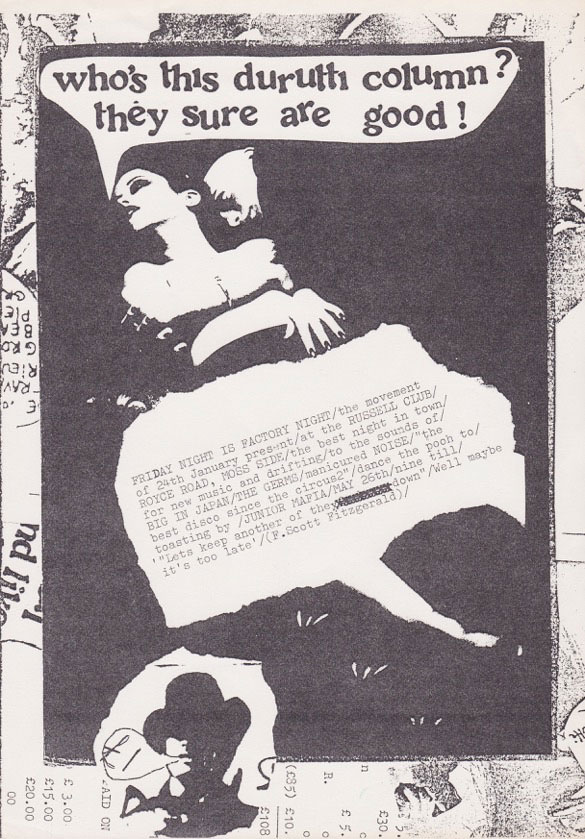
Within a week or two, Peter Saville had produced FAC1, the seed-bed of the whole Factory aesthetic as it is now understood. Almost immediately, Saville’s cool, modern, typographically led approach became associated as the Factory brand: out of the first ten FAC numbers, Saville designed all but two—and those were Linder’s never completed Menstrual Egg Timer and a Factory film night. The singularity and colourful clarity of Saville’s vision took Factory products out of the purview of punk and set the course for the 1980s and beyond.
Nevertheless the punk/montage/pro-situ influence remained in the background of Factory practice—seen in the images here. Many of these were roughs by Tony Wilson, A4 sheets hurriedly rushed off to suit an immediate purpose—like the ‘Cowboys’ ad for a Durutti Column singer, or the speech bubbles on the xerox sheet advertising A Certain Ratio’s first single, All Night Party (FAC 5), or a rough for the August 1979 ‘Zoo Meets Factory Halfway’ Leigh Festival that he designed very much in the style of Peter Saville.
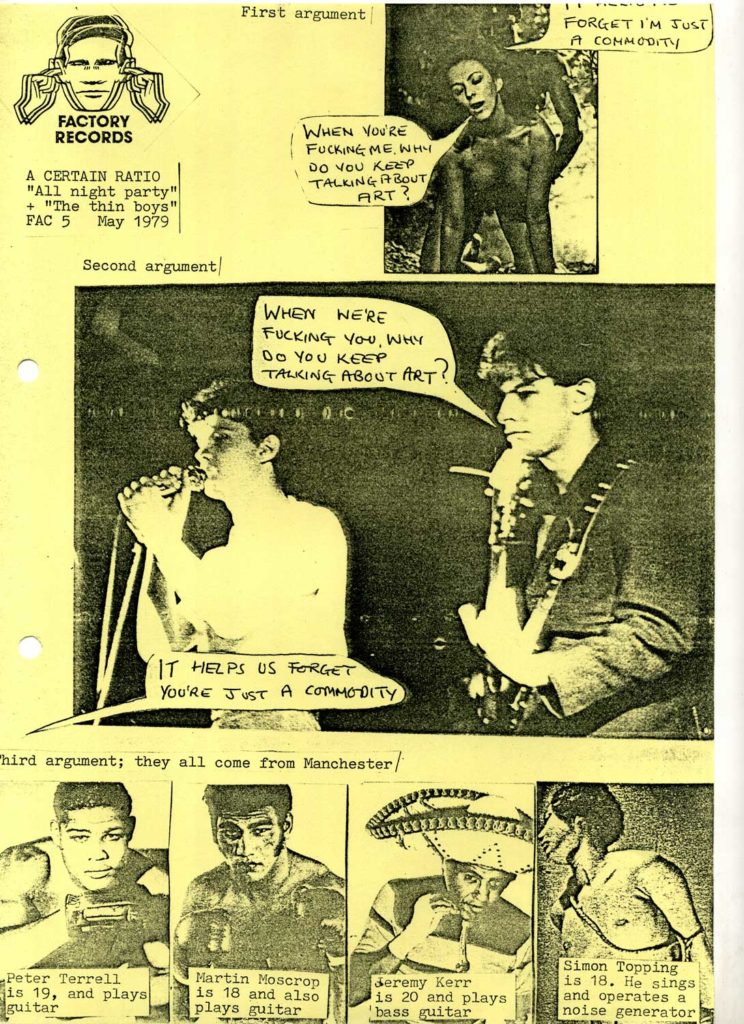
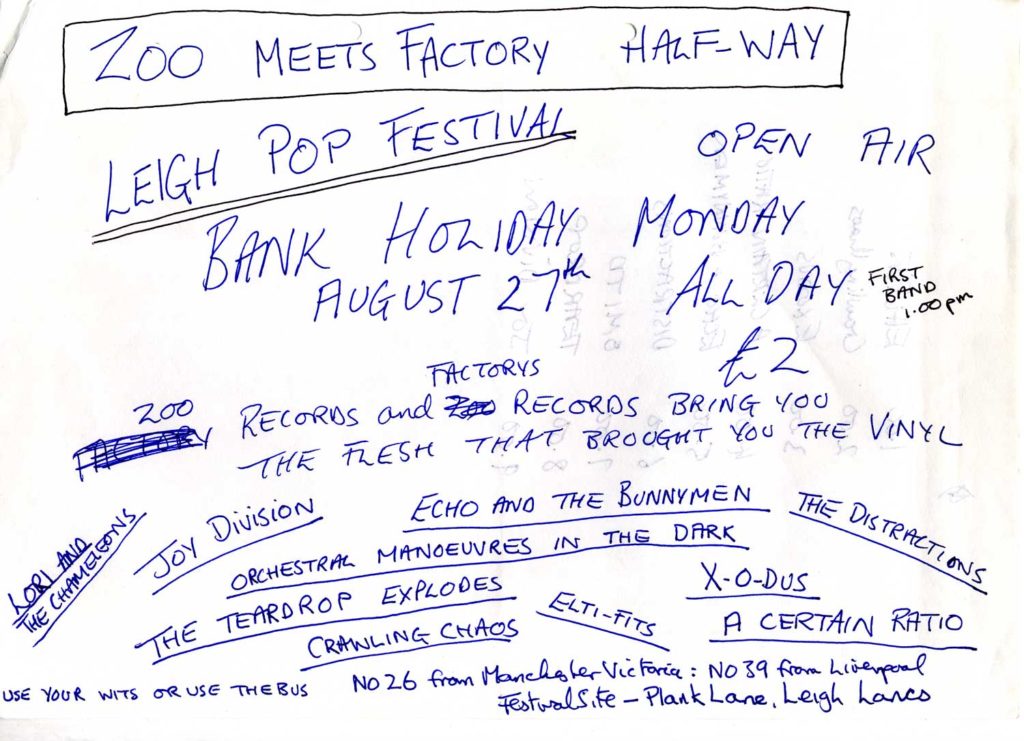
Tony was a catalyst in those years. Anyone who had anything to bring to the table was roped in. Linder Sterling made a montage handbill for a Joy Division/Tiller Boys show at the Factory on 9 June 1978—an excellent example of her feminist montage technique. Tony also got me to design a couple of posters for Joy Division and others for A Certain Ratio and the Durutti Column. I didn’t get paid but I got the pleasure of seeing the images printed large and posted all over Manchester.
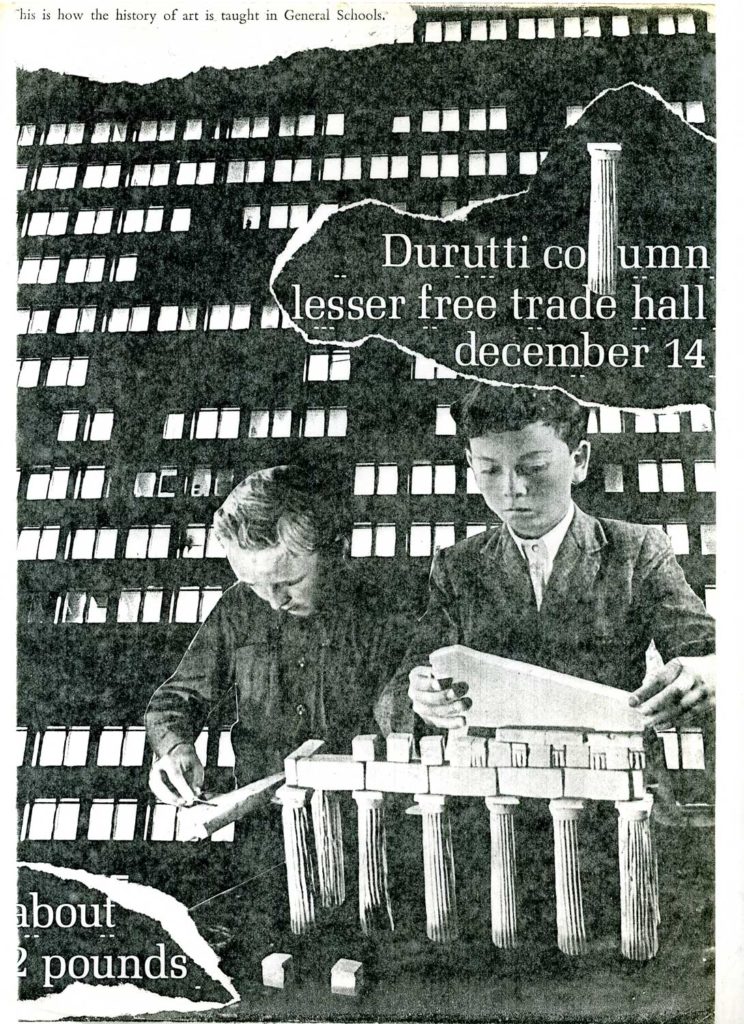
There was another, more thoughtful side to the punk influence. Rob Gretton’s notebooks from late 1978 through early 1979 show that the theory and practice of operating outside the mainstream music industry was well thought through. His handwritten thoughts and comments on the assembly of Joy Division’s first album Unknown Pleasures (FACT 10) comprise artworks in themselves—quite apart from the information they give about this ground-breaking release: alternate tracks, alternate album titles etc.
The Situationist influence on Wilson remained constant during this first flush of Factory. The sandpaper sleeve for the Durutti Column’s first album, The Return of the Durutti Column (FACT14) was an idea taken direct from a book by Guy Debord, Mémoires. Urban drift was shot through the visuals inspired by the music of Joy Division—in particular the song ‘Shadowplay’, in its visual incarnation on Granada TV and the psychogeographical tour through Hulme and Central Manchester seen in Charles Salem’s super 8 film No City Fun, shown in September 1979 as part of a Factory Film night (FAC 9).
Most of all, there was the nightclub that inaugurated the second phase of Factory. In Ivan Cthcheglov’s founding vision of Urbanism, there was the initial diagnosis—‘We are bored in the city, there is no longer any Temple of the Sun’—and the solution, expressed in a ringing phrase: ‘The hacienda must be built’. That project would be known as FAC 51—which, like its 15-year history that went from boredom to ecstasy to violence—is a number and a story that is outside the ambit of the Use Hearing Protection exhibition.